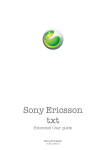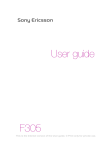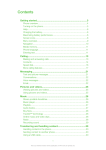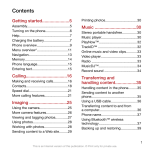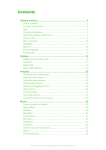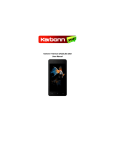Download Sony Ericsson J108I User's Manual
Transcript
Sony Ericsson J108i Extended User guide Contents Getting started..............................................................................5 Phone overview...................................................................................6 Turning on the phone..........................................................................7 Help....................................................................................................9 Charging the phone............................................................................9 Maximising battery performance.......................................................10 Screen icons.....................................................................................12 Menu overview..................................................................................13 Navigation.........................................................................................14 Memory............................................................................................15 Phone language................................................................................16 Entering text......................................................................................16 Chinese input....................................................................................17 Calling..........................................................................................18 Making and answering calls..............................................................18 Contacts ..........................................................................................20 Speed dial.........................................................................................23 More calling features.........................................................................23 Music ..........................................................................................27 Music player......................................................................................27 Playlists.............................................................................................28 Audio books......................................................................................29 Buy Now...........................................................................................29 Online music and video clips.............................................................29 Entertainment.............................................................................30 Radio ...............................................................................................30 TrackID™ application .......................................................................30 PlayNow™ application......................................................................31 Recording sound ..............................................................................31 Imaging .......................................................................................32 Viewfinder and camera keys..............................................................32 Using the still camera........................................................................32 Using the video camera.....................................................................33 Viewing and tagging photos..............................................................34 Using photos.....................................................................................34 Using web albums............................................................................35 Accessing videos in your phone........................................................35 Transferring and handling content...........................................37 Organising your content....................................................................37 2 This is an Internet version of this publication. © Print only for private use. Copyright protected content.............................................................37 Handling content in the phone..........................................................37 Sending content to another phone....................................................38 Connecting your phone to a computer..............................................38 Transferring content to and from a computer....................................40 Phone name.....................................................................................40 Using Bluetooth™ wireless technology..............................................40 Backing up and restoring..................................................................41 Updating your phone.................................................................42 Updating your phone using Sony Ericsson PC Companion...............42 Messaging...................................................................................43 Text and picture messages...............................................................43 Conversations...................................................................................44 Voice messages................................................................................44 Email.................................................................................................44 Internet .......................................................................................48 To access the web browser toolbar..................................................48 Web browser shortcuts.....................................................................48 Bookmarks.......................................................................................48 History pages....................................................................................49 More browser features......................................................................49 Internet settings................................................................................49 Modem functionality..........................................................................50 File transfers......................................................................................52 Web feeds........................................................................................52 Synchronising.............................................................................54 Synchronisation options in Sony Ericsson PC Companion.................54 Synchronising using SyncML™.........................................................54 Synchronising using a Microsoft® Exchange Server..........................55 Synchronising using a computer.......................................................55 Synchronising using an Internet service.............................................56 More features.............................................................................57 Flight mode.......................................................................................57 Location services..............................................................................57 Alarms..............................................................................................57 Calendar...........................................................................................58 Notes................................................................................................59 Tasks................................................................................................59 Profiles..............................................................................................59 Time and date...................................................................................60 Themes.............................................................................................60 Main menu layout..............................................................................60 3 This is an Internet version of this publication. © Print only for private use. Screen orientation.............................................................................60 Ringtones..........................................................................................60 Games..............................................................................................61 Applications......................................................................................61 Antivirus............................................................................................61 PIN codes.........................................................................................62 Keypad lock......................................................................................63 IMEI number.....................................................................................63 Troubleshooting.........................................................................64 Common questions...........................................................................64 Error messages.................................................................................66 Legal information.......................................................................68 Index............................................................................................70 4 This is an Internet version of this publication. © Print only for private use. Getting started Important information Please read the Important information leaflet before you use your mobile phone. 5 This is an Internet version of this publication. © Print only for private use. Phone overview 1 Connector for handsfree 1 2 Ear speaker 2 3 Connector for charger and USB cable 4 Screen 5 Selection keys 3 6 Call key 4 7 Activity menu key 8 Navigation key 9 Speaker 5 10 Keylock key 11 11 End key, On/off key 12 6 7 12 C key (Clear) 8 9 10 13 Camera lens 14 Volume, digital zoom key 15 Microphone 13 16 Strap holder 14 16 15 6 This is an Internet version of this publication. © Print only for private use. To insert the SIM card 1 2 • Open the cover and insert the SIM card with the gold-coloured contacts facing down. To insert the battery 1 2 1 2 Insert the battery with the label side up and the connectors facing each other. Attach the battery cover. Turning on the phone To turn on the phone 1 2 3 4 . Press and hold down Enter your SIM card PIN (Personal Identification Number), if requested, and select OK. Select a language. Follow the instructions that appear. If you want to correct a mistake when you enter your PIN, press . 7 This is an Internet version of this publication. © Print only for private use. SIM card The SIM (Subscriber Identity Module) card, which you get from your network operator, contains information about your subscription. Always turn off your phone and detach the charger before you insert or remove the SIM card. You can save contacts on the SIM card before you remove it from your phone. PIN You may need a PIN (Personal Identification Number) to activate the services and functions in your phone. Your PIN is supplied by your network operator. Each PIN digit appears as *, unless it starts with emergency number digits, for example, 112 or 911. You can see and call an emergency number without entering a PIN. If you enter the wrong PIN three times in a row, the SIM card is blocked. See SIM protection on page 62. Standby After you have turned on your phone and entered your PIN, the name of the network operator appears. This view is called standby. Your phone is now ready for use. Widget Manager You can show, hide or add widgets by using Widget Manager. A widget is a live update on a website, web page or desktop. Widgets contain personalised content or applications selected by the user. 1 2 3 1 2 3 4 1 2 To start a widget From standby, press the navigation key up. To select a widget, press the navigation key left or right. Press Select to start the widget. To manage widgets From standby, press the navigation key up. Select Manage. Widget icons appear. To select a widget, press the navigation key left or right. Select Hide to hide a widget or Show if you want the widget to appear in the standby screen. To turn off Widget Manager From standby, select Menu > Settings > Display > Standby application. Select None. Notes widget Use the Notes widget to make notes, add new tasks and view them from your Widget screen. 1 2 3 To access the Notes widget From standby, press the navigation key up to access the Widget screen. Find and mark the Notes widget by pressing the navigation key left or right. Select Show if you want the widget to appear in the Widget screen. Clock widget Use the Clock widget to customise your clock with different layout options and time zone displays. 1 2 3 To access the Clock widget From standby, press the navigation key up to access the Widget screen. Find and mark the clock widget by pressing the navigation key left or right. Select Show if you want the widget to appear in the Widget screen. 8 This is an Internet version of this publication. © Print only for private use. Using other networks You may incur additional costs when you roam outside of your home network. For example, if you make calls or use messaging and Internet-based services in another network, you may have to pay more. Contact your operator for more information. Help In addition to this User guide, more information is available at www.sonyericsson.com/cn. There are also help functions and a User guide in your phone. See the following instructions on how to access them. • To access the User guide in your phone Select Menu > Settings > User help > User guide. • To view tips and tricks Select Menu > Settings > User help > Tips and tricks. • To view information about functions Scroll to a function and select Info, if available. In some cases, Info appears under Options. • To view the phone demonstration Select Menu > Entertainment > Demo tour. • To view the phone status Press a volume key. Phone, memory and battery information is shown. Supported services and features Some of the services and features described in this User guide are not supported by all networks and/or service providers in all areas. Without limitation, this applies to the GSM International Emergency Number 112. Please contact your network operator or service provider to determine availability of any specific service or feature and whether additional access or usage fees apply. Charging the phone Your phone battery is partly charged when you but it. There are two ways to charge the battery. 9 This is an Internet version of this publication. © Print only for private use. 2 1 It may take 30 minutes for the battery icon to appear on the screen. • • To charge the phone using the power adapter Connect your phone to a power outlet using the USB cable provided and the power adapter. To charge the phone using a computer Connect your phone to a USB port on a computer using the USB cable provided. If your phone is powered off it will turn on automatically when you connect it to a computer using the USB cable. The battery will start to discharge a little after it is fully charged and then charges again after a certain time. This is to extend battery life and may result in the charge status showing a level below 100 percent. Note • To charge your phone, Sony Ericsson strongly recommends that you use only Sony Ericsson branded original batteries, a power supply which is in accordance with specification YD/T 1591-2006 (a Communications Industry standard of P. R. China) , and the USB cable supplied with your phone. The use of third-party products may decrease the performance of your phone and/or pose a risk to your health or safety You can charge the battery for more or less than 3 hours. Interrupted charging does not damage the battery. Performance depends on temperatures, signal strength, usage patterns, features selected and voice or data transmissions. The stand-by time for this battery is up to 415 hours in GSM network; up to 485 hours in UMTS network (the test results are based on GSMA battery life test technology). Use only Sony Ericsson branded original batteries intended for use with your mobile phone. If you use other batteries you may not be able to charge your phone. Maximising battery performance • • • Charge your phone often. The battery lasts longer if you charge it frequently. If you are in an area with no coverage, your phone repeatedly scans for available networks. This consumes power. If you cannot move to an area with better coverage, turn off your phone temporarily. Turn off 3G and Bluetooth™ wireless technology when you do not need these functions. 10 This is an Internet version of this publication. © Print only for private use. • Do not cover the phone antenna when you are engaged in a call. Go to www.sonyericsson.com/support to learn more about how to maximise the battery performance. 11 This is an Internet version of this publication. © Print only for private use. Screen icons These icons may appear on the screen: Icon Description The battery is almost fully charged The battery needs charging The network coverage is good No network coverage (also shown in flight mode) A 3G network is available A UMTS HSPA network is available Missed calls Calls diverted Ongoing call The microphone is muted The loudspeaker is on The phone is in silent mode New text message New multimedia message New email The music player is playing The radio is playing A handsfree is connected The Bluetooth function is activated A Bluetooth headset is connected The phone is connected to the Internet Secure website An alarm is activated Appointment reminder Task reminder A Java™ application is activated Activating Antivirus USB cable is connected 12 This is an Internet version of this publication. © Print only for private use. Menu overview* PlayNow™ Camera Alarms Calls** Radio TrackID™ Location services Games Record sound Demo tour Media Dialled Photo Music Video Games Web feeds Settings Missed Calendar Internet Settings All Answered Messaging Write new Inbox/Conversations Messages Email Call voicemail Contacts Myself New contact Organiser Applications File manager ** File transfer Tasks Notes Synchronisation Timer Stopwatch Calculator Entertainment Online services General Profiles Time & date Language Update software Voice control Shortcuts Flight mode Automatic keylock PIN codes Security Phone status Master reset Sounds & alerts Ring volume Ringtone Silent mode Increasing ring Vibrating alert Message alert Key sound Theme Startup screen Screen saver Brightness Calls Speed dial Smart search Divert calls Manage calls Time Show/hide my no. Handsfree Connectivity Bluetooth USB Phone name Synchronisation Device management Mobile networks Internet settings Streaming settings Message settings SIP settings Accessories User help User guide Basic setup Tips and tricks GreenHeart™ * Some menus are operator-, network- and subscriptiondependent. ** You can use the navigation key to scroll between tabs in submenus. Display Wallpaper Main menu layout 13 This is an Internet version of this publication. © Print only for private use. Navigation • • To access the main menu When Menu appears on the screen, press the centre selection key to select Menu. If Menu does not appear on the screen, press , and then press the centre selection key to select Menu. To navigate the phone menus • Press the navigation key upwards, downwards, left or right to move through the menus. • To select actions on the screen Press the left, centre or right selection key. • To view options for an item Select Options to, for example, edit. • To end a function . Press • To return to standby Press . 1 2 3 To navigate your media Select Menu > Media. Scroll to a menu item and press the navigation key right. To go back, press the navigation key left. • To delete items Press to delete items such as numbers, letters, pictures and sounds. Tabs Tabs may be available. For example, Calls have tabs. • To scroll between tabs Press the navigation key left or right. Shortcuts You can use the navigation key shortcuts to go directly to functions from standby. • To use navigation key shortcuts Press the navigation key upwards, downwards, left or right to go directly to a function. 14 This is an Internet version of this publication. © Print only for private use. 1 2 3 To edit a navigation key shortcut Select Menu > Settings > General > Shortcuts. Scroll to an option and select Edit. Scroll to a menu option and select Shortc.. Main menu shortcuts Menu numbering starts from the top left icon and moves across and then down row by row. • To go directly to a main menu item Select Menu and press – , , or . The Main menu layout must be set to Grid. See To change the main menu layout on page 60. Activity menu The activity menu gives you quick access to: • • • • New events – missed calls and new messages. Running apps – applications that are running in the background. My shortcuts – add your favourite functions to access them quickly. Internet – connect conveniently to the Internet. • To open the activity menu Press . Memory You can save content on a memory card, in the phone memory and on the SIM card. Photos and music are saved on the memory card, if a memory card is inserted. If not, or if the memory card is full, photos and music are saved in the phone memory. Messages and contacts are saved in the phone memory, but you can choose to save them on the SIM card. Memory card You may have to purchase a memory card separately. Your phone supports a microSD™ memory card, adding more storage space to your phone. This type of card can also be used as a portable memory card with other compatible devices. You can move content between a memory card and the phone memory. To insert a memory card • Remove the battery cover and insert the memory card with the gold-coloured contacts facing down. 15 This is an Internet version of this publication. © Print only for private use. To remove a memory card • Remove the battery cover and press the edge of the memory card to release and remove it. Phone language You can select a language to use in your phone. 1 2 To change the phone language Select Menu > Settings > General > Language > Phone language. Select an option. Entering text You can use multitap text input or Quick text input to enter text. The Quick text input method uses a dictionary application in your phone. • To change the writing language When you enter text, press and hold down • To change the text input method When you enter text, press and hold down • To shift between upper- and lower-case letters or numbers When you enter text, press . 1 2 To enter numbers When you enter text, press To enter a number, press repeatedly until – . . . appears at the top of the screen. To enter a number from text input mode, you can press and hold down 1 2 – . To enter punctuation marks and symbols briefly. When you enter text, press Scroll to a symbol and select Insert. When you enter Chinese, you can insert full-size symbols such as 。 or 《. To open the full-size symbol table, press and select Full. To select from the most commonly used punctuation marks, you can also press 1 2 3 4 5 . To enter text using Quick text input Select, for example, Menu > Messaging > Write new > Message. is not displayed, press and hold down to change to Quick text input. If Press each key only once, even if the letter you want is not the first letter on the key. , , , . Write the whole For example, to write the word “Jane”, press word before looking at the suggestions. To view word suggestions, press or press the navigation key downwards. Press to accept a suggestion and add a space. 16 This is an Internet version of this publication. © Print only for private use. 1 2 3 4 To enter text using the multitap method Select, for example, Menu > Messaging > Write new > Message. If is displayed, press and hold down to change to multitap text input. Press – repeatedly until the desired letter appears. Press to add a space. Multitap input only applies when Latin characters are selected as input language. 1 2 To add words to the phone dictionary When you enter text using Quick text input, select Options > Spell word. Write the word using multitap input and select Save. Chinese input • • Stroke input Pinyin input General instructions Your phone has a function to speed up the entry of Chinese characters. Whenever you enter a stroke or a Pinyin letter, a candidate row of the most frequently used characters containing that stroke or relating to that letter appears at the bottom of the screen. Stroke input A Chinese character is built up of strokes. There are more than 30 basic strokes, which are grouped into 5 stroke categories. Components The basic building units of Chinese characters are components that are made up of strokes. After entering the first two strokes of the desired character, the component and character candidates that started with that stroke are displayed in the candidate row. Using components is a fast method for entering complex characters. Pinyin input Select the required Pinyin letters, and the phone will make various proposals on the screen, according to the pronunciation rules of Mandarin. 17 This is an Internet version of this publication. © Print only for private use. Calling You need to turn on your phone and be within range of a network. Making and answering calls • To end a call Press . • To re-dial a number When Retry? appears, select Yes. Do not hold your phone to your ear when waiting for the call to connect. When the call connects, your phone gives a loud signal. • To answer a call Press . • To reject a call Press . • To change the ear speaker volume during a call Press the volume keys up or down. 1 2 To mute the microphone during a call Press and hold down . appears. Press and hold down again to resume. • To turn on the loudspeaker during a call Select Spkr on. appears. Do not hold the phone to your ear when using the loudspeaker. This could damage your hearing. • To view missed calls from standby appears. Press to open the call list. Background music You can add background music to an ongoing call. When activated, background music can be heard by all participants. When the microphone is muted, the background music continues to play. • To start playing background music during a call During the call, select Music. See To play music on page 27. • To stop playing background music during a call Press the centre selection key. • To change the background music volume during a call Press the volume key up or down. Only the music volume can be changed when the music is playing. Video call During a video call, you can share video from the main camera. 18 This is an Internet version of this publication. © Print only for private use. Before making video calls 3G (UMTS) service is available when or appears. To make a video call, both parties on the call must have a 3G (UMTS) phone subscription that supports 3G (UMTS) service and 3G (UMTS) coverage. 1 2 To make a video call Enter a phone number (with international country code and area code, if applicable). Select Options > Make video call. • To use the zoom with an outgoing video call Press the navigation key upwards or downwards. 2 To share photos and videos during a video call During a video call, press the navigation key left to switch to the video share mode tab. Scroll to a video clip or photo and select Share. • To view video call options During the call, select Options. 1 Emergency calls Your phone supports international emergency numbers, for example, 112 or 911. You can normally use these numbers to make emergency calls in any country, with or without the SIM card inserted, if you are within range of a network. In some countries, other emergency numbers may also be promoted. Your network operator may therefore have saved additional local emergency numbers on the SIM card. • 1 2 To make an emergency call Enter 112 (the international emergency number) and press . To view your local emergency numbers Select Menu > Contacts. Scroll to New contact and select Options > Special numbers > Emergency numbers. Networks (UMTS) or networks Your phone switches automatically between GSM and depending on availability. Some network operators allow you to switch networks manually. 1 2 To switch networks manually Select Menu > Settings > Connectivity > Mobile networks > GSM/3G networks. Select an option. Call list , dialled You can view information about answered 1 2 To call a number from the call list Press and scroll to a tab. Scroll to a name or a number and press and missed or rejected . 19 This is an Internet version of this publication. © Print only for private use. calls. Contacts You can save names, phone numbers and personal information in Contacts. Information can be saved in the phone memory or on the SIM card. You can synchronise your contacts using the Sony Ericsson PC Companion. Add the area code when you save fixed line numbers in your phone. Migrating contacts You can move contact information from most Nokia phones to your Sony Ericsson phone. Your phone is able to convert file formats for contact information from both S40 and S60 Nokia phones. However, some information may not be transferable if the information fields do not match. Before you can transfer the contact information, you need to back up the contacts to your Nokia phone memory card. 1 2 3 4 5 6 7 To migrate contact information from a Nokia phone to your Sony Ericsson phone Back up your contact information to the MicroSD card in the Nokia phone. Insert the same MicroSD card into your Sony Ericsson phone. Select Menu > Organiser > Applications > Contact migration to automatically search for files on the MicroSD card. Select the files you want to add to the Contacts application in your Sony Ericsson phone. For each file, mark the contacts you want to import. Select Options > Import to import the selected contacts. Press OK to finish. Default contacts You can choose which contact information is shown by default. If Phone contacts is selected as the default, only contact information saved to the phone memory is listed in Contacts. If you select SIM contacts as the default, only names and numbers saved on the SIM card are shown in Contacts. 1 2 3 To select default contacts Select Menu > Contacts. Scroll to New contact and select Options > Advanced > Default contacts. Select an option. Phone contacts Phone contacts can contain names, phone numbers and personal information. They are saved in the phone memory. 1 2 3 4 5 6 7 8 To add a phone contact Select Menu > Contacts. Scroll to New contact and select Add. Enter the name and select OK. Scroll to New number: and select Add. Enter the number and select OK. Select a number option. Scroll between the tabs and add information to the fields. Select Save. Calling contacts 1 2 To call a contact written in Chinese characters Select Menu > Contacts. Enter the entire multi-letter name, pure initial or mixed initial Pinyin of Chinese contacts you want to call. When the contact is highlighted, press navigation key left or right to select a number. Press the Call key. 20 This is an Internet version of this publication. © Print only for private use. 1 2 To call a contact written in Latin letters Select Menu > Contacts. Scroll to, or enter the first letters or all letters of the contact you want to call (a maximum of 10 letters). When the contact is highlighted, press the navigation key left or right to select a number. Press the Call key. The phone supports a mixed search of Chinese and English contacts. When a contact is written in Latin characters, the entered letter can reach the Latin contact you want to call. When a contact is written in Chinese characters, the entered letter can reach the Pinyin of the Chinese contact you want to call. 2 To make a call using Smart search Press – to enter a sequence of (at least two) digits. All entries that match the sequence of digits, or corresponding letters, are shown in a list. . Scroll to a contact or a phone number and press 1 2 To turn on or off Smart search Select Menu > Settings > Calls > Smart search. Select an option. 1 Editing contacts 1 2 3 4 5 To add information to a phone contact Select Menu > Contacts. Scroll to a contact and select Options > Edit contact. Scroll between the tabs and select Add or Edit. Select an option and an item to add or edit. Select Save.









































































